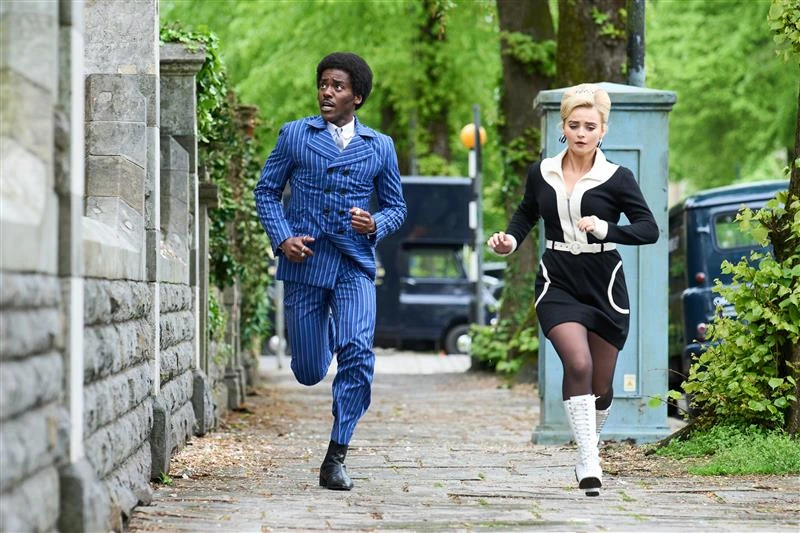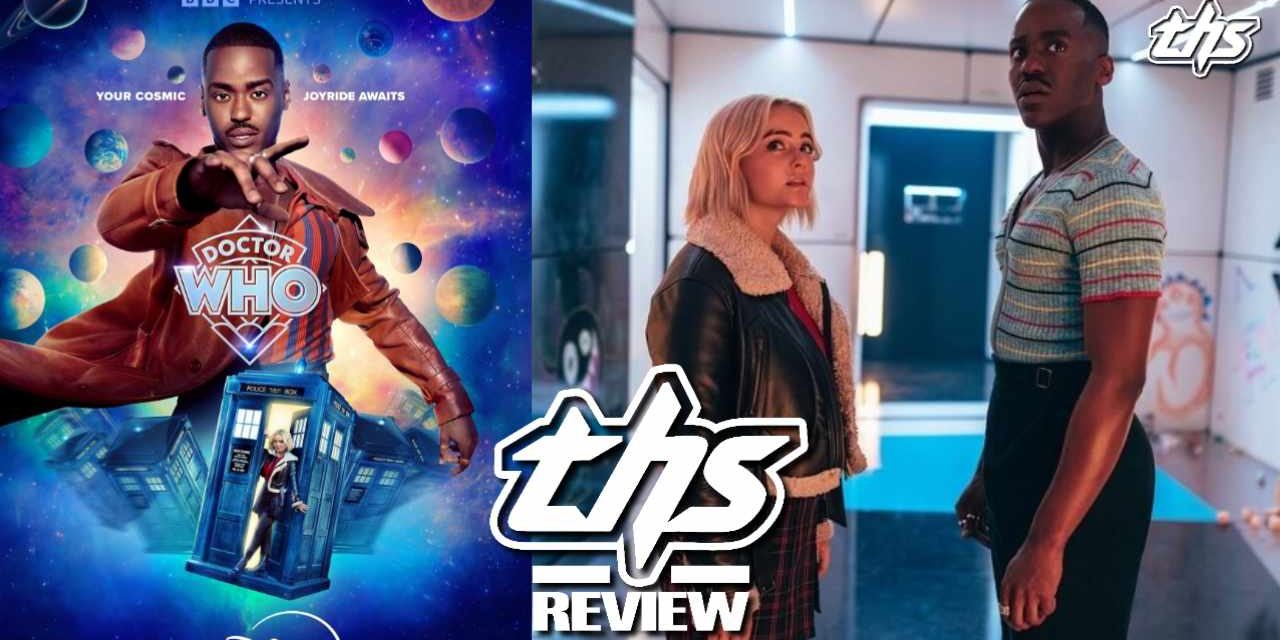Episode 1 of the softly rebooted 14th Doctor Who series, “Space Babies”, starts seconds after the Christmas special, “The Church On Ruby Road”, ends. Written by Russell T Davies, it opens with The Doctor (Ncuti Gatwa) and Ruby (Millie Gibson) inside the TARDIS.
This is the first episode to be broadcast on Disney + alongside the BBC. The BCC has been airing the sci-fi show since it started in November 1963. The show clearly expects new audiences as the first minutes are dedicated to explaining the lore of The Doctor, the TARDIS, and his now-gone home planet. This will be tedious to committed fans of the show, who want to jump into the action yet get stuck listening to the Wikipedia explanation of Doctor Who. There could have been more seamless ways to incorporate the lore into the opening episode than this rather on-the-nose explanation.
Doctor Who “Space Babies”
The Doctor and Ruby initially travel back in time to see dinosaurs. Despite being a heavily promoted clip, their visit back to prehistoric times is fleeting and exclusively exists to fulfill one time-travel gag. It’s moments like this where the Disney+ budget is showcased. Gone are the days of running around Cardiff quarries disguised as alien planets. Minus the budget boost and cast update, this still feels like the Doctor Who fans will know and love.
The real setting of “Space Babies” is a futuristic spaceship that essentially exists as an incubator for babies to be grown for planets where natural conception is not possible. Only the adults who once cared for their babies have left these little ones to their own devices. Our space-traveling duo finds that the spaceship is empty, minus a murky monster, some talking babies, and Nan-E’s guiding voice. The babies left alone on the kindergarten ship may look like infants, but they have evolved enough to be able to control the spaceship and talk. The result is a terrifying mix of babies with CGI moving mouths who can drive a spaceship yet have the emotional needs of one-year-olds. It’s very funny, but the uncanniness can dive into the creepy.
“Space Babies” – The Perfect Opening
The opening episode is a strong introduction to this updated and big-budget world of Doctor Who. It’s an ideal opening episode for people looking to start the show but feel overwhelmed by the many decades of episodes. The writing is funny, the right amount of silly, with a decent monster for the duo to defeat. Returning showrunner Russell T. Davies (who brought the show back in 2005 with Christopher Eccleston but left in 2010) has always understood the core of the show and how to balance character development, whimsy, and scares.
Amongst all the space baby fun, Davies isn’t afraid to make a political point. This is something that has become a signature since Davies left the show (he penned It’s a Sin about the AIDS pandemic in the 1980s and Years and Years about an alternative ultra-right-wing environment). The existence of an incubator spaceship full of undocumented babies allows Davies to make subtle but powerful points about refugees, immigration, and pro-choice.

Doctor Who “The Devil’s Chord”
The second episode, “The Devil’s Chord”, is less successful than the opener. Also written by Davies, the duo head back to 1960s Swinging London to see The Beatles make their seminal Abbey Road album. When they enter the studio, they find the Fab Four tuneless; making silly little ditties that are nowhere near the quality expected from the iconic band. This world lacks melody, and music is seen as a negative force in the world that shouldn’t be encouraged.
There is sure to be controversy about how poor the resemblance is between the actors (George Caple, Chris Mason, Philip Davies, and James Hoyles) and the real-life The Beatles. The lack of resemblance in both looks and mannerisms is almost distracting. Josie Sedgwick-Davies’ appearance as Scouse singer Cilla Black is even less believable.
A World Without Melody
History is being changed by Maestro (Jinkx Monsoon), a mysterious God-like entity who wants a world without melody. Jinkx, who originally found fame on RuPaul’s Drag Race; is having a ball in this mischievous role that wouldn’t have felt out of place in The Rocky Horror Picture Show. Sadly, their larger-than-life performance can’t make this uneven plot and poor pacing work.
This idea of a villain stealing music from the world is zany but interesting; yet in practice, it doesn’t translate on screen. Despite a genius performance by Jinkx Monsoon, the writing is unusually one-dimensional and flat. It has to be praised that the showrunner, who has penned over 30 episodes of Doctor Who, still has new places to take the drama. The showdown is experimental and unlike anything the show has done before. Sadly, there might have been a reason why a music-themed Doctor Who episode has not happened before.

Ncuti Gatwa is confident in the role, adding a new, sexier spin on the timelord. The alien awkwardness is gone, now replaced with an assured assertiveness. It’s refreshing to see the show trying something new with the character rather than trying to replicate the success of previous regenerations. From the opening episode, it’s clear that Gatwa can perfectly handle the delicacy of Davies’ writing and the mix of sensitivity and eccentricity.
Millie Gibson’s Ruby is a less successful addition to the show. She is thinly written and lacks the impact of previous companions. It also feels like the chemistry between her and The Doctor doesn’t quite match some of the previous relationships, although it clearly has room to grow. Ruby doesn’t quite have enough dimensions to make her feel like a fully formed character. But this may change throughout the series.
Ruby’s origins as a baby mysteriously abandoned at Christmas continue to be an arc that will run long into the season. Clues keep breaking into their reality, making it clear that Ruby and The Doctor’s encounter during the Christmas special is more than just a coincidence.
The opening two episodes feel strangely distant after such an emotive Christmas special. While there is lots of fun to be had, it feels like audiences have yet to really meet The Doctor and Ruby. While the breadcrumbs have been laid out for later episodes, these two outings feel like self-contained stories that require no knowledge of the Whoniverse. This is a perhaps telling sign of this new Disney+ regeneration of the British staple, geared more towards a casual American viewer.
For more updates on Doctor Who, check back to THS.
You can stream the premiere on Disney+ starting May 10.




